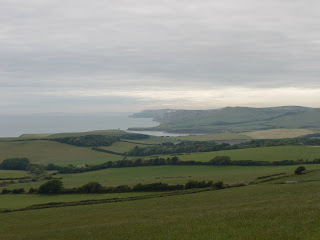It was cool (12 degrees) with very low cloud when we set out, although the forecast was that it would clear later. As we snaked up through the clouds towards the lake, we did just begin to wonder if we would be able to see anything at all when we arrived. And when we did finally reach the car park at the Col de Gueulaz (1960m), beside the dam which created the lake, the cloud was so low that we could hardly see the other side of the car park.
The walk begins in a most unusual way: you walk through a tunnel through the rock for about half a mile. I took this photo without flash and although the very slow shutter speed has led to it being blurred, it gives a reasonable sense of the tunnel - although in reality it was much darker.
When we emerged at the other end, we began to walk along a causeway high above the lake, which was apparently to our our left. The first views through the cloud were tantalising.
However, we did see the first of many wonderful alpine flowers: this lovely Alpine Rhododendron - rather like an azalea.
A bit further along the path we saw this fine collection of plants growing up the base of the overhanging cliff. We had the sense of a Japanese garden lovingly tended, but presumably it was the fruit of natural processes.
As we walked further on the cloud began to lift and the bright periods grew longer. The original 1920s dam came into view, with mountains behind it.
And now there was another fine flower sighting: this wonderful Red Gentian, just coming into flower. We also saw large and small Blue Gentian, but I could not seem to get satisfactory photos of either.
I still haven't identified this similarly coloured flower shot against the background of the mountains on the far side of the lake.
As we descended to reach a locality called Barberine, where a old workmen's camp was ornamented by a traditional French cockerel, the sky cleared further and the farthest limit of the reservoir became apparent. The water is unusually low at present as major engineering works are undertaken.
We decided to turn round here and head back. In due course the new dam finally revealed itself to us, with bare rocky mountains behind. Mont Blanc was hidden in the clouds high above to the left.
Conditions: hot (mid 20s), although cooler under the clouds. Sunburn was discovered later.
Distance: 4 miles or so.
Rating: four stars.
Other sightings
We spotted three splendid varieties of orchid.

We were too high up to see many butterflies. Some blues, a lone Apollo, but right at the end a Mountain Ringlet decided to land on my leg. A first.

















































